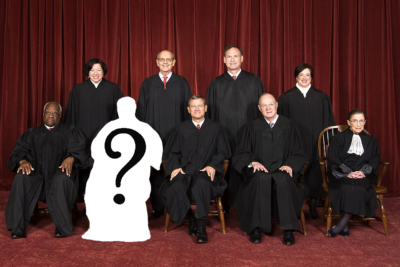President Trump’s Supreme Court Nominee & Murr-murs of Behind-the-Scenes Supreme Court Intrigue
Will Trump’s Supreme Court Pick Prompt Long-Awaited Decision in Key Property Rights Case?
 In his wide-ranging, long-awaited and (to put it mildly) colorful press conference last week, President Trump promised to announce his nominee to the U.S. Supreme Court within two weeks of taking the oath of office. On this pledge, at least, I believe him. Indeed, I’ll be surprised if he waits that long.
In his wide-ranging, long-awaited and (to put it mildly) colorful press conference last week, President Trump promised to announce his nominee to the U.S. Supreme Court within two weeks of taking the oath of office. On this pledge, at least, I believe him. Indeed, I’ll be surprised if he waits that long.
Senate Republicans refused to give President Obama’s Supreme Court nominee Merrick Garland so much as a Judiciary Committee hearing over the last ten months. But I predict the Senate leadership will move on President Trump’s nominee, once announced, with warp speed. Pressure has been building to fill the Court vacancy created by Justice Scalia’s death last January.
And that likely flurry of senatorial action has direct consequences for environmental law. It means that a long-pending property rights case may still receive oral argument and be decided in the current Term.
 The case is Murr v. Wisconsin, No. 15-214. Legal Planet colleague Ann Carlson ably summarized this important regulatory takings challenge in an earlier post. In brief, the Murr case involves a David-vs.-Goliath land use dispute between a Wisconsin family and state and local government officials. The fight is over the Murrs’ vacation home property along the St. Croix River, owned by the family for over a half-century. At various points in the property’s history, it consisted of two separate, adjoining lots–one developed with the longstanding family cabin, the other vacant. As a result of intra-family transfers, the Murr property has been deemed by local land use officials to have been merged into a single legal lot. So when the Murr family sought to sell the undeveloped portion of the property as a separate lot, the government refused to allow it. The Murr family responded by filing suit against the county and state, asserting that the government’s denial of their attempt to sell the vacant parcel constitutes an unconstitutional “regulatory taking” of their property for which monetary compensation must be paid.
The case is Murr v. Wisconsin, No. 15-214. Legal Planet colleague Ann Carlson ably summarized this important regulatory takings challenge in an earlier post. In brief, the Murr case involves a David-vs.-Goliath land use dispute between a Wisconsin family and state and local government officials. The fight is over the Murrs’ vacation home property along the St. Croix River, owned by the family for over a half-century. At various points in the property’s history, it consisted of two separate, adjoining lots–one developed with the longstanding family cabin, the other vacant. As a result of intra-family transfers, the Murr property has been deemed by local land use officials to have been merged into a single legal lot. So when the Murr family sought to sell the undeveloped portion of the property as a separate lot, the government refused to allow it. The Murr family responded by filing suit against the county and state, asserting that the government’s denial of their attempt to sell the vacant parcel constitutes an unconstitutional “regulatory taking” of their property for which monetary compensation must be paid.
Out of such humble local land use disputes is significant constitutional and land use law made. The Supreme Court granted review in Murr in January 2016. The case shapes up as the justices’ most important review of a key principle of regulatory takings law–the “relevant parcel” or “denominator” issue–since the Supreme Court first announced that principle in its landmark Penn Central Transportation Co. v. City of New York decision four decades ago. The doctrinal question is: what is the relevant property interest that is alleged to have been “taken” by government action? How that threshold issue is framed quite often dictates the substantive outcome in a regulatory takings case. In Murr, if the relevant parcel for purposes of the landowners’ constitutional challenge is the entire property owned by the Murrs, that property indisputably retains substantial economic value and the family will lose the case. Conversely, if the relevant parcel is deemed to be the undeveloped portion of the Murr property that the government has decreed may not be sold, that property may be viewed by the justices as nearly or completely valueless for Takings Clause purposes, and the Murr family may well prevail.
Moreover, how the Supreme Court frames and decides the “relevant parcel” issue in Murr could have enormous consequences for regulatory takings law generally–a fact not lost on the conservative Pacific Legal Foundation, legal counsel for the Murr family. PLF has a strong record of finding property rights cases with compelling facts and sympathetic clients, and getting those cases to–and often winning them before–the Supreme Court.
But the most compelling aspect of Murr v. Wisconsin is the behind-the-scenes Supreme Court intrigue the case has generated.
As noted above, certiorari in Murr was granted a full year ago. Justice Antonin Scalia, the Court’s foremost property rights activist, doubtless was one of the justices voting in favor of review. A month later, however, Scalia was dead. Given the U.S. Senate’s adamant refusal to consider former President Obama’s nominee to replace Scalia on the Court, until now there have been only eight justices available to decide the Murr case.
Here’s where things get really interesting.
Given the timing of the Court’s grant of certiorari, it was fully expected that the Murr case would be calendared for oral argument last October, at the beginning of the Court’s current Term. It wasn’t, however. Nor did Murr appear on the justices’ oral argument calendars in November, December, January or February. So, what’s going on?
The prevailing view–which I share–is that the justices (or at least Chief Justice Roberts) have concluded that with Justice Scalia’s passing, the remaining eight justices are likely to split 4-4 on the result in the Murr case, with Justice Kennedy and the conservative wing of the Court voting in favor of the Murr family and the four progressive members of the Court siding with the government defendants. Such a vote and result would deprive the Murr case of any precedential effect.
Accordingly, it’s likely that the justices have been delaying oral arguments in the Murr case until a critical ninth justice has been confirmed by the Senate and joins the Court. With the change in presidential administrations, the new justice will now be picked by President Trump. He or she is likely to be sympathetic to private property rights, skeptical of government regulation and thus disposed to provide the critical fifth vote in favor of the Murr plaintiffs and a potentially-sweeping property rights victory for PLF and its allies. All of this provides additional incentive for the Trump Administration to nominate, and the Senate to confirm, a new, conservative Supreme Court justice as quickly as possible. If they do, there’s still time for the Murr case (along with a handful of other cases that have similarly been awaiting oral argument for over a year) to be argued in March or April and decided by the end of the Court’s current Term in June.
A quick postscript: cognizant of the doctrinal significance of the Murr case, the Obama Administration’s Solicitor General last year sought and was granted the right to participate in oral argument in Murr as a friend-of-the-court. That’s unusual enough, but the justices also extended time for oral arguments in Murr to accommodate the Solicitor General, which is even more rare. Ironically, President Trump’s Solicitor General, should s/he decide to stay in the case, is likely to advocate a much different legal position–one far more sympathetic to the Murr family’s constitutional arguments–than that of the now-departed Obama administration.
In sum, the Murr case is about to be jump-started at the Supreme Court, and the prospects of the Murr plaintiffs and their property rights supporters for a major property rights victory have been enhanced considerably as a result of both Court intrigue and dramatic political change.
Reader Comments
One Reply to “President Trump’s Supreme Court Nominee & Murr-murs of Behind-the-Scenes Supreme Court Intrigue”
Comments are closed.







Dear Professor Frank,
Your insightful comments regarding the Murr case reveal a note of optimism which is warmly merited on this splendid Inauguration Day in America. Our next Supreme Court Justice should hopefully bring forth some badly needed reparations in our legal justice system by faithfully upholding a strict interpretation of constitutional law. Thanks for sharing your thoughts, have a good day.